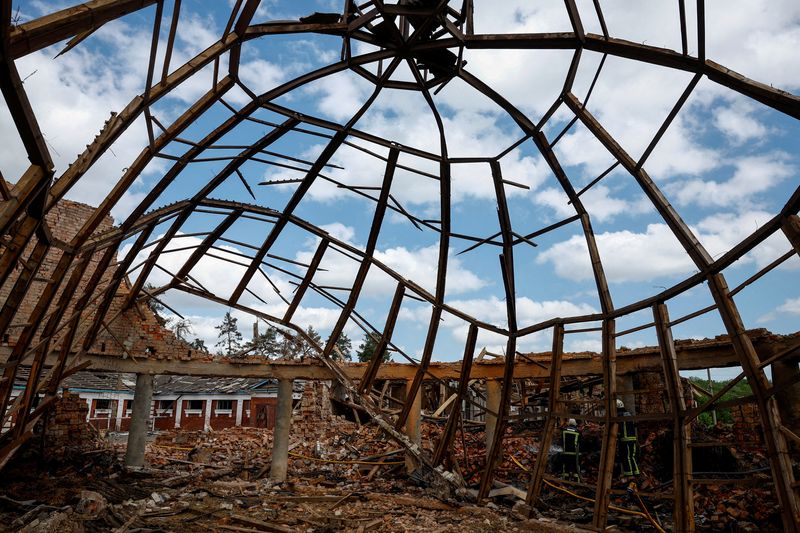Analysis-Biden tip-toes deeper into Ukraine conflict with arms decision
2024.05.31 16:53
By Phil Stewart, Jonathan Landay and Max Hunder
WASHINGTON/KYIV (Reuters) – President Joe Biden’s decision to relax some restrictions on Ukraine’s use of U.S. weaponry inside Russia is a small but significant step deeper into the two-year-old war that experts say could help blunt Russia’s cross-border Kharkiv offensive.
Since Russia’s 2022 invasion of Ukraine, Biden’s administration had argued it was too risky to allow Ukraine to strike targets on Russia territory with U.S.-supplied weapons. It feared a major Ukrainian attack could trigger direct conflict with nuclear-armed Russia.
It was a rule that fit neatly with other U.S. prohibitions on supplying higher-end weaponry to Kyiv that have also since crumbled, from advanced U.S. fighter jets to long-range ATACM missiles.
Biden administration officials say the latest decision, which went into effect on Thursday, was narrowly tailored to the battle in the Kharkiv region. U.S. officials say it allows Kyiv to use U.S.-supplied weapons to fire back against Russian forces “attacking them or preparing to attack them” from across the border.
That gives Ukrainians on the frontlines a green light to fire over the border at Russian forces using U.S.-supplied High Mobility Artillery Rocket System (HIMARS) launchers armed with Guided Multiple Launch Rocket System (GMLRS) missiles, and other weaponry, experts say.
“This can stabilize the frontline and possibly create conditions to push back (Russians) from Kharkiv region before they have dug in,” said Mykola Bielieskov, research fellow at the Ukrainian National Institute for Strategic Studies, an official think-tank in Kyiv.
Philip Ingram, a former British military intelligence officer, said Biden’s decision will reduce Kyiv’s need to draw troops away from critical battle fronts in the eastern Donbas region.
“The Russians are now going to find themselves on the back foot and will have to rethink the tactics they have been using in their attack into Kharkiv,” he said.
SLOW-CHURN DECISION
Biden’s decision-making process dates back weeks.
Ukraine raised its request to use U.S. weapons across the border in the Kharkiv region during a secure video conference on May 13 with White House National Security Director Jake Sullivan, Defense Secretary Lloyd Austin, and Chairman of the Joint Chiefs of Staff General C.Q. Brown, a U.S. official said, speaking on condition of anonymity.
Sullivan, Austin and Brown developed a recommendation in favor of relaxing the restrictions, which Sullivan took to Biden on May 15. Biden agreed Ukraine should be able to strike back against Russian forces attacking them from the safety of Russian soil, the official said. Biden’s administration had been finalizing the decision since then.
Ukrainian President Volodymyr Zelenskiy publicly called for Ukraine’s partners to take such a step in a May 20 interview with Reuters, but at the time said: “So far, there is nothing positive.”
Rob Lee, a senior fellow at the Foreign Policy Research Institute’s Eurasia Program, said Russia had been exploiting Biden’s prohibition on strikes inside Russian territory by using it as a safehaven to launch attacks in Kharkiv region.
Kharkiv, Ukraine’s second largest city, is just 19 miles (30 km) from the border.
“Russia could keep its artillery right across the border. It could keep air defense, electronic warfare, command and control (there),” Lee said. “It had maybe a degree of kind of sanctuary.” Still, Lee and other experts this decision on its own may not alter the frontlines anytime soon.
“I don’t think (the decision) is going to change the movement of the frontline that much, if at all. But it will make it more difficult for Russia to continue this kind of cross-border operation,” Lee said. Ingram said Russia lacks enough troops for a major push into Kharkiv.
“The Russians don’t have the ability to generate sufficient combat capability to properly threaten Kharkiv from the northeast,” he said. “To do that, it would denude their troops in eastern combat areas.”
DEEPER STRIKES IN RUSSIA?
Russian President Vladimir Putin has warned NATO members against allowing Ukraine to fire their weapons into Russia and on Tuesday once again raised the risk of nuclear war.
Still, Ukraine appears ready to seek to expand its ability to use U.S. weaponry elsewhere in Russia in the weeks and months to come, particularly after a difficult year in which Russia seized the momentum on the battlefield.
On Friday, less than a day after Washington announced its policy shift, Zelenskiy was quoted in an interview with the Guardian newspaper calling for U.S. approval to hit targets deep inside Russian territory.
Mark Cancian, a former Pentagon official now at the Center for Strategic and International Studies think-tank in Washington, said Biden’s move was just a first step.
“It’s not a radical departure (in policy). But it’s a step,” Cancian said.
“Ukrainians and officials in the administration will argue for the next step: To strike a broader set of targets — maybe targets in Russia that are not directly threatening Kharkiv, but are in other areas.”

U.S. Secretary of State Antony Blinken, speaking on Friday in Prague, declined to say whether the Biden administration could expand its policy to allow strikes elsewhere in Russia. But he did not rule it out.
“Going forward, we’ll continue to do what we’ve been doing, which is as necessary adapt and adjust,” Blinken said.








